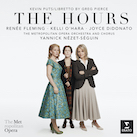

Kevin Puts: The Hours
Erato
Using the kaleidoscopic design of Michael Cunningham's 1998 novel and Stephen Daldry's 2002 film version as blueprints, Pulitzer Prize-winning composer Kevin Puts has fashioned a mesmerizing treatment of The Hours that extends their own remarkable creations to the opera stage. In his collaboration with librettist Greg Pierce, Puts replicates the interweaving of the three protagonists' stories by having the score blend the events of each woman's day into a fluid, ever-flowing convergence of soaring vocal and instrumental sound. For this recording, the 142-minute work was captured live on December 10th, 2022 with Yannick Nézet-Séguin leading New York's Metropolitan Opera Orchestra.
Just as the film is elevated by the acting of Meryl Streep, Julianne Moore, and Nicole Kidman, the opera's distinguished by the vocal artistry of sopranos Renée Fleming and Kelli O'Hara and mezzo-soprano Joyce DiDonato in the respective roles of Clarissa Vaughan, Laura Brown, and Virginia Woolf. The story-lines unfold over a single day: set in the ‘80s, the first involves Clarissa, a NYC-based book editor who's preparing a party for her AIDS-afflicted poet friend Richard; the second places Virginia in Richmond in 1923 as she grapples with the anxiety of a new novel's beginning; and the third concerns Laura, a pregnant housewife agonizing over her life choices while living in the Los Angeles suburbs in the late ‘50s with her husband Dan and son Richie. In crafting his libretto, Pierce streamlined the novel without losing its essence. Whereas it begins with a prologue recounting Woolf's suicide, for instance, the opera places us immediately within Clarissa's hectic life, and details about her daughter Julia and Julia's partner Mary are omitted too.
While their stories might seem distinct, connections abound: Brown reads passages from Woolf's Mrs. Dalloway, and consistent with the book's opening line, “Mrs. Dalloway said she would buy the flowers herself,” Clarissa (who shares her first name with Woolf's protagonist) is busy with, among other things, buying flowers for Richard's party. As Paul Cremo writes in his synopsis, by the end of the opera's first act, “The three women are united in their need to escape and in their terror of what they might find.” One of the smartest choices Puts made was to move away from the scene-shifting structure of the novel and film for a design that allows the story-lines to overlap and intersect. Such an approach allows for duos where one woman's voice couples with another's (e.g., Laura and Virginia during act one, scene six and act two, scene two) and also allows for a powerful closing scene that sees the three protagonists sharing the stage and delivering a glorious trio, the stirring gesture calling to mind, of course, the finale of Richard Strauss's Der Rosenkavalier.
The even more brilliant choice Puts made has to do with his decision to devise a different musical environment for each woman: Woolf's music exudes a subtle Baroque quality, with harmonic shifts and hints of dissonance reflecting her complex nature; Brown's references the swooning swing of Lawrence Welk and other ‘50s-era figures but in a way that accentuates her feelings of alienation and anxiety; and Vaughan's possesses the urgency and pulsing thrust of post-minimalism and the visceral energy of Bernstein. The appearance of metronomic rhythms reinforces the sense of propulsion within the protagonists' lives and draws a direct line to the time-related theme of the work.
Puts' orchestration is magnificent, and so is his oft-lyrical, animated, and luscious score. The emotional scope is broad too, with tenderness, longing, and desperation expressed in tandem with music that segues seamlessly between agitation and serenity. During the opera's dream-like intro, the words of the novel's opening line are sung by the vocal chorus, the gesture a direct nod to the book. Following that, the insistent pulsation of Clarissa's scenes conveys the frantic pace of her day (her scenes aren't all manic, however, as shown when the music slows elegiacally during her visits with Richard at his apartment); Virginia's, by comparison, slows the tempo for a contemplative, inward-looking episode, with the vocal chorus's “flowers, flowers” interjections hinting at the inner activity of the writer's mind. At the start of act two, Laura's stay at the hotel is accompanied by music of particular delicacy and nuance.
Each protagonist wrestles with things in her life, be they artistic, psychological, practical, or otherwise, that struggle captured in words Richard says to Clarissa about his dread over having to face the party and the ceremony, “and then the hour after that, and the hour after that … One and then another, and you get through that one and then, my god, there's another.” He, the women, and by extension we too can't evade the existential dilemma of figuring out what to do with our lives, of how to make them meaningful and ensure they have some kind of purpose.
Far into the second act, Clarissa arrives at Richard's upper-floor apartment to find him perched precariously in the frame of an open window. Ending tragically, it's a powerful scene, but another, comparatively quieter one is more devastating (spoiler alert): when his mother meets Clarissa face-to-face, we realize, of course, that the poet was also Mrs. Brown's young son Richie. At that moment, whatever separation there is between the two story-lines vanishes when Laura literally steps into Clarissa's world. The hush of Puts' dignified music enhances the singers beautifully during this poignant moment.
Complementing the exceptional contributions of Fleming, O'Hara, and DiDonato is a stellar supporting cast that includes Kyle Ketelsen (Richard), Sean Panikkar (Leonard Woolf), Kathleen Kim (the florist Barbara), Brandon Cedel (Dan), Kai Edgar (Richie), Sylvia D'eramo (Kitty), William Burden (Louis), and others. Caveats? Few to speak of, though the inclusion of a libretto with the release would have been nice. Couple the brilliance of Puts' score—the fourth opera by the St. Louis-born composer—with the leads' breathtaking voices and the orchestra's inspired realization and the result is a life-affirming opera that amply rewards the, yes, hours needed to fully appreciate it.April 2024